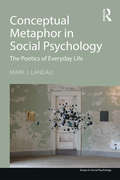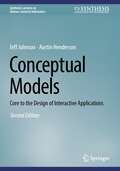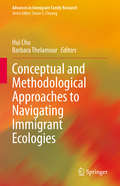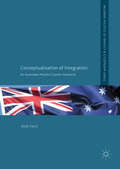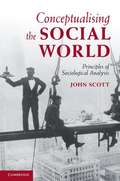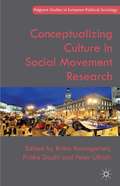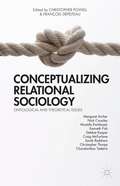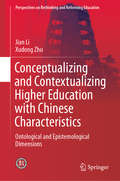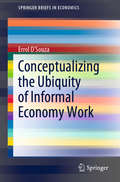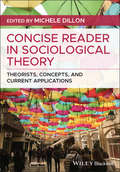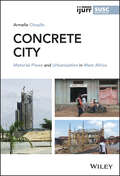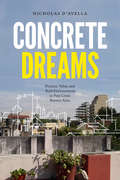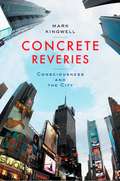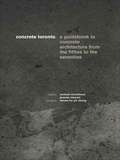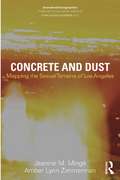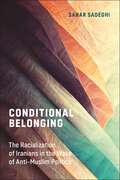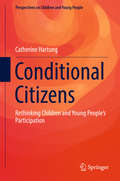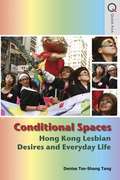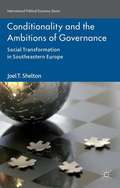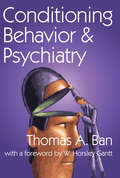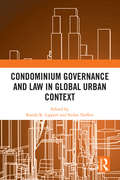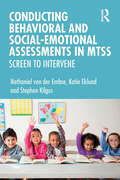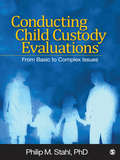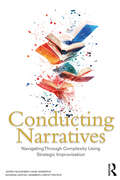- Table View
- List View
Conceptual Metaphor in Social Psychology: The Poetics of Everyday Life (Essays in Social Psychology)
by Mark J. LandauWe learn in grade school that metaphor is an ornamental figure of speech reserved for poets. But we now know that it is also a key strategy people use to make sense of the world, from basic concepts like time and causation to the major social issues facing society. In this book, Mark Landau clarifies with wide-ranging evidence the many ways conceptual metaphor guides our thoughts and actions, shining a light on the cognitive underpinnings of social life. Conceptual Metaphor in Social Psychology synthesizes over twenty-five years of in-depth research. Drawing from innovative experiments conducted around the globe, Landau shows conclusively that individuals and groups use metaphor—often unconsciously—to grasp abstractions, make judgments and decisions, communicate, and organize their behavior. Each chapter explores metaphor’s importance for understanding a major topic in social psychology: social cognition, motivation, culture, the self, interpersonal relationships, intergroup dynamics, politics, and health. What emerges is a powerful explanation of how social behavior is shaped by and reflected in our bodily functioning, cultural context, and language use. Integrating insights from cognitive linguistics, anthropology, and personality, this book makes a compelling case that conceptual metaphor has a pervasive effect on human affairs. Researchers in social psychology will discover new ways to think about and investigate these related topics, while students of psychology will learn about an exciting development in understanding enduring questions about who we are and how we got that way.
Conceptual Models: Core to the Design of Interactive Applications (Synthesis Lectures on Human-Centered Informatics)
by Jeff Johnson Austin HendersonThis book presents readers with an exploration of the concept of Conceptual Models and argues that they are core to achieving good design of interactive applications that are easy, effective, and enjoyable to use. The authors’ years of experience helping companies create interactive software applications revealed that interactive applications built without Conceptual Models generally result in fraught production processes and designs that are confusing and difficult to learn, remember, and use. Instead, the book shows that Conceptual Models can be a central link between the elements involved in the use of interactive applications: people’s tasks (domains), their plans for performing those tasks, the use of applications in the plans, the conceptual structure of applications, the presentation of the conceptual model (i.e., the user interface), the terms used to describe it, its implementation, and the learning that people must do to use the application. Readers will learn how putting a Conceptual Model at the core of the design and development process can pay rich dividends: designs are simpler, more coherent, and better aligned with users’ tasks; unnecessary features are avoided; documentation is easier, development is faster and cheaper; customer uptake is improved; and the need for training and customer support is reduced. To support its use in instruction, this second edition has been revised to explain the history and theoretical context of conceptual modeling using a consistent vocabulary, describe the structure of conceptual models, provide more current and more complete examples, explain how conceptual models fit into design and development, and further summarize the benefits of conceptual modeling.
Conceptual and Methodological Approaches to Navigating Immigrant Ecologies (Advances in Immigrant Family Research)
by Hui Chu Barbara ThelamourThis book compiles a series of empirical and conceptual chapters based on Bronfenbrenner’s ecological theory as the framework for understanding the overlapping and intersecting contexts that influence different populations of migrants in the United States and Canada. According to Bronfenbrenner’s model, individuals engage in activities and relationships that directly impact them, including families, schools, and jobs (microsystems), the interrelations among microsystems like family-school (mesosystems), contexts that have an impact on the individual through indirect influences (exosystems), and the overarching cultural milieus in which members share values, beliefs, and lifestyles (macrosystems). Within this edited volume, family, school, work, media, policies, culture, and sociohistorical contexts are examined to understand their influence on immigrant groups. This edited volume also considers immigrants across development and ethnic groups to provide a comprehensive resource on the issues that currently affect immigrant groups.
Conceptualisation of Integration: An Australian Muslim Counter-Narrative (Palgrave Politics Of Identity And Citizenship)
by Abdi HersiThis book identifies and examines the meanings of integration from the perspective of Australian Muslims, through analysis of focus group discussions and in-depth interviews in the South East Queensland region. It provides a comprehensive overview of Muslim conceptualisation of integration, and the author explores the various meanings Muslims ascribe to it, such as participation, belonging and contributing to the wider societyBy gaining an understanding of how Muslims define integration, this research can help policy makers, academics and settlement service providers to appreciate how culture and faith influence the meanings diverse groups give to certain accepted terms. It will be of interest to scholars and students in the fields of migration, mobility, integration and social cohesion.
Conceptualising the Social World
by John ScottThis comprehensive and authoritative statement of fundamental principles of sociological analysis integrates approaches that are often seen as mutually exclusive. John Scott argues that theorising in sociology and other social sciences is characterised by the application of eight key principles of sociological analysis: culture, nature, system, structure, action, space-time, mind and development. He considers the principal contributions to the study of each of these dimensions in their historical sequence in order to bring out the cumulative character of knowledge. Showing that the various principles can be combined in a single disciplinary framework, Scott argues that sociologists can work most productively within an intellectual division of labour that transcends artificial theoretical and disciplinary differences. Sociology provides the central ideas for conceptualising the social, but it must co-exist productively with other social science disciplines and disciplinary areas.
Conceptualizing Culture in Social Movement Research
by Britta Baumgarten Priska Daphi Peter UllrichThis volume introduces and compares different concepts of culture in social movement research. It assesses their advantages and shortcomings, drawing links to anthropology, discourse analysis, sociology of emotions, narration, spatial theory, and others. Each contribution's approach is illustrated with recent cases of mobilization.
Conceptualizing Relational Sociology
by Christopher Powell François DépelteauEdited by François Depelteau and Christopher Powell, this volume and its companion, Applying Relational Sociology: Networks, Relations, addresses fundamental questions about what relational sociology is and how it works.
Conceptualizing and Contextualizing Higher Education with Chinese Characteristics: Ontological and Epistemological Dimensions (Perspectives on Rethinking and Reforming Education)
by Jian Li Xudong ZhuThis book provides a fresh and unique overview of the modernization and internationalization of Chinese higher education, focusing on Chinese higher education from 1949 to 2018. It presents the Ontological Positivism Model (Conceptualization-Explicit-Formal-Share), concentrating on concepts of Chinese higher education.The book is intended for scholars and researchers in the field of comparative higher education, administrators and stakeholders in education management and graduate students majoring in higher education.
Conceptualizing the Ubiquity of Informal Economy Work (SpringerBriefs in Economics)
by Errol D’SouzaThis book provides a framework to understand the disregarded aspect of emerging market growth which is informal employment. Informal employment in unregistered enterprises or of workers without employment contracts or social protection contributions constitutes 88 per cent of employment in India and is a ubiquitous feature of the economy. A large proportion of informal employment (86 per cent) is self-employment and this category of employment has been neglected in the literature on work and development which has focused instead on wage employment that is a contract for work with another person or enterprise. Another striking feature of such economies which the book engages with is that, as they have liberalized, informal employment in the registered enterprises or formal part of the economy has grown. The informal sector has been analyzed by recourse to two major approaches. One is a public economics framework that underlines how informal enterprises evolve as they trade-off reduced access to public services such as contract enforcement with the payment of taxes and regulatory compliances. This book extends this literature by focusing on the access to formal sector credit and its potential for financing productive enterprises as a factor that is considered when an enterprise contemplates whether to incorporate or not. The second leg of the literature takes a labour perspective and emphasizes mandated labour costs such as hiring and firing costs, benefits, and minimum wages as considerations when deciding on whether to engage labour on a formal or informal basis. The book broadens this literature by taking into account how the human capital of workers and the monitoring costs of ensuring that workers are adhering to the terms of negotiated contracts inform the decision with regard to informality. The book will resonate with those academics and policy makers who are engaged with the conundrums of development.
Concise Reader in Sociological Theory: Theorists, Concepts, and Current Applications
by Michele DillonEssential writings from classical and contemporary sociological theorists engagingly introduced and brought to life for students This Concise Reader in Sociological Theory contains excerpts from the writings of a wide range of key theorists who represent the dynamic breadth of classical and contemporary, macro- and micro-sociological theory. The selected writings elaborate on the core concepts and arguments of sociological theory, and, along with the commentary, explore topics that resonate today such as: crisis and change, institutions and networks, power and inequality, race, gender, difference, and much more. The text contains editorial introductions to each section that clearly explain the intellectual context of the theorists and their arguments and reinforce their relevance to sociological analysis and society today. The excerpts include writings from the classicists Karl Marx, Max Weber, Emile Durkheim, W.E.B. Du Bois to the contemporary Patricia Hill Collins, Dorothy Smith, Raewyn Connell. This indispensable book: Offers a concise review of the diverse field of sociological theory Includes contributions from a wide range of noted classical and contemporary theorists Incorporates engaging empirical examples from contemporary society Demonstrates the relevance and significance of the ideas presented in the theorists’ writings Designed for undergraduate and graduate students in sociology and in social and political theory, Concise Reader in Sociological Theory is an engaging and accessible guide to the most relevant sociological theorists.
Concrete City: Material Flows and Urbanization in West Africa (IJURR Studies in Urban and Social Change Book Series)
by Armelle ChoplinCONCRETE CITY “Armelle Choplin’s Concrete City weaves a novel and engaging analysis of urbanization by tracing the journeys of cement and people making urban life in West Africa. From post-independence high modernist ambitions to building the opportunities to make a living, the emerging transnational corridor along the West African coast provides a starting point for insights which will expand and inform understanding of both established and newly emerging urbanization processes in many different contexts.” —Jennifer Robinson, Professor of Geography, University College of London, UK “In this very innovative and superbly illustrated book, Armelle Choplin makes cement vibrant with affect, politics, economic interests and cultural meanings. She takes us to a fascinating journey along the West African urban corridor following the social life of concrete and showing how this material shapes contemporary urbanization and everyday life.” —Ola Söderström, Professor of Geography, University of Neuchâtel, Switzerland Concrete City: Material Flows and Urbanization in West Africa delivers a theoretically informed, ethnographic exploration of the African urban world through the life of concrete. Emblematic of frenetic urban and capitalistic development, this material is pervasive, shaping contemporary urban landscapes and societies and their links to the global world. It stands and circulates at the heart of major financial investments, political forces and environmental debates. At the same time, it epitomises values of modernity and success, redefining social practices, forms of dwelling and living, and popular imaginaries. The book invites the reader to follow bags of cement from production plant to construction site, along the 1000-kilometre urban corridor that links Abidjan to Accra, Lomé, Cotonou and Lagos, combining the perspectives of cement tycoons, entrepreneurs and political stakeholders, but also of ordinary men and women who plan, build and dream of the Concrete City. With this innovative exploration of urban life through concrete, Armelle Choplin delivers a fascinating journey into and reflection on the sustainability of our urban futures.
Concrete Dreams: Practice, Value, and Built Environments in Post-Crisis Buenos Aires
by Nicholas D'AvellaIn Concrete Dreams Nicholas D&’Avella examines the changing social and economic lives of buildings in the context of a construction boom following Argentina's political and economic crisis of 2001. D&’Avella tells the stories of small-scale investors who turned to real estate as an alternative to a financial system they no longer trusted, of architects who struggled to maintain artistic values and political commitments in the face of the ongoing commodification of their work, and of residents-turned-activists who worked to protect their neighborhoods and city from being overtaken by new development. Such forms of everyday engagement with buildings, he argues, produce divergent forms of value that persist in tension with hegemonic forms of value. In the dreams attached to built environments and the material forms in which those dreams are articulated—from charts and graphs to architectural drawings, urban planning codes, and tango lyrics—D&’Avella finds a blueprint for building livable futures in which people can survive alongside and even push back against the hegemony of capitalism.
Concrete Reveries: Consciousness and the City
by Mark KingwellAn exploration of urbanism, personal identity, and how the space we live in shapes us<P> According to philosopher and cultural critic Mark Kingwell, the transnational global city—New York and Shanghai—is the most significant machine our species has ever produced. And yet, he says, we fail again and again to understand it. How do cities shape us, and how do we shape them? That is the subject of Concrete Reveries, which investigates how we occupy city space and why place is so important to who we are.<P> Kingwell explores the sights, smells, and forms of the city, reflecting on how they mold our notions of identity, the limits of social and political engagement, and our moral obligations as citizens. He offers a critique of the monumental architectural supermodernism in which buildings are valued more for their exteriors than for what is inside, as well as some lively writing on the significance of threshold structures like doorways, lobbies, and porches and the kinds of emotional attachments we form to ballparks, carnival grounds, and gardens. In the process, he gives us a whole new set of models and metaphors for thinking about the city.
Concrete Toronto: A Guide to Concrete Architecture from the Fifties to the Seventies
by Michael Mcclelland Graeme StewartAfter World War II, concrete became increasingly popular as a building medium around the world. Brutalism, the fashion for plain, heavy design, reigned. Toronto was particularly affected. The city has concrete buildings of all stripes international landmarks, metropolitan infrastructure and even the single family home. Hundreds of these structures were built, including Viljo Revells groundbreaking New City Hall, John Andrews seminal Scarborough College and the record-smashing CN Tower. Toronto is a city cast in concrete. However, as architectural fashion has shifted from postmodernism to the glass-and-steel neomodernism of today, these concrete structures have been ignored, misunderstood and, in some cases, demolished. Concrete Toronto acts as a guide to the city's extensive concrete heritage. A diverse group of experts has been assembled to re-examine the uniqueness and value of these buildings. Included are the insights of many of the original concrete architects, university faculty, local practitioners, journalists and industry experts. Together they explore the past and future of Toronto's concrete buildings. Included is a wealth of new and archival photos, drawings, interviews, articles, as well as case studies of Toronto's major concrete architecture.
Concrete and Dust: Mapping the Sexual Terrains of Los Angeles
by Jeanine Marie Minge Amber Lynn ZimmermanConcrete and Dust focuses on the performative nature of sexualized identity in Hollywood, the people that live in its underbelly and surrounding valleys, the sexual geographies of the place, and the ways in which sexual agency is mapped on the body and in consciousness. The cultural turn in ethnography has expanded the scope of ethnographic research methods, which now include innovative techniques that recognize and value sensuous scholarship (ethnographic works that incorporate visual, aural, and sensory texts). Hollywood has often been a focus in critical cultural theory; absent from the field is a holistic methodological perspective that collages visual image, arts-based ethnographic and autoethnographic narratives, experimental sound, poetry, and performative writing, in order to juxtapose the conflicting and complex performative nature of Hollywood, celebrity, glamour, and sexual agency.
Conditional Belonging: The Racialization of Iranians in the Wake of Anti-Muslim Politics
by Sahar SadeghiA compelling account of how race and politics have affected Iranian immigrants in the United Statesand GermanyIranians have a complex and contradictory relationship with race. Though categorized as “white” by the US census, many Iranian Americans remain marginalized, and experience racial and political stigma daily. On the other hand, Iranian Germans who have been in Germany for decades, and are typically regarded as 'good foreigners,' continue to experience marginality and discrimination illustrating the limitations of integration and citizenship. Conditional Belonging explores these apparent contradictions through a comparative analysis of the Iranian diasporic experience in the United States and Germany, focusing particularly on the different processes of racialization of the immigrants.Drawing from eighty-eight interviews with first- and second-generation Iranians living in California and Hamburg, Sahar Sadeghi illuminates how international events, global political policy, and national social climates influence the extent to which Iranians define themselves as members of their adopted nations. All these factors lead to radically different experiences of belonging, or more specifically “conditional belonging,” for Iranians living in Western nations—while those in America might have situational access to whiteness, this is not always available to Iranians in Germany. The combination of these experiences results in perceptions, narrations, and experiences of what the author calls “being but not belonging.” Conditional Belonging is an important and timely book that broadens our understanding of how unpredictable and fluid a sense of belonging to a country can be.
Conditional Citizens: Rethinking Children and Young People’s Participation (Perspectives on Children and Young People #5)
by Catherine HartungThis book challenges readers to recognise the conditions that underpin popular approaches to children and young people's participation, as well as the key processes and institutions that have enabled its rise as a global force of social change in new times. The book draws on the vast international literature, as well as interviews with key practitioners, policy-makers, activists, delegates and academics from Japan, South Africa, Brazil, Nicaragua, Australia, the United Kingdom, Finland, the United States and Italy to examine the emergence of the young citizen as a key global priority in the work of the UN, NGOs, government and academia. In so doing, the book engages contemporary and interdisciplinary debates around citizenship, rights, childhood and youth to examine the complex conditions through which children and young people are governed and invited to govern themselves. The book argues that much of what is considered 'children and young people's participation' today is part of a wider neoliberal project that emphasises an ideal young citizen who is responsible and rational while simultaneously downplaying the role of systemic inequality and potentially reinforcing rather than overcoming children and young people's subjugation. Yet the book also moves beyond mere critique and offers suggestive ways to broaden our understanding of children and young people's participation by drawing on 15 international examples of empirical research from around the world, including the Philippines, Bangladesh, the United Kingdom, North America, Finland, South Africa, Australia and Latin America. These examples provoke practitioners, policy-makers and academics to think differently about children and young people and the possibilities for their participatory citizenship beyond that which serves the political agendas of dominant interest groups.
Conditional Spaces: Hong Kong Lesbian Desires and Everyday Life
by Denise Tse-Shang TangThis book offers an in-depth sociological study on Hong Kong lesbian and transgender lesbian subjectivities and their materialization within multiple spaces. Based on thirty life history interviews, the author attempts to map the complex relations between lesbian subjectivities and spatialities as they emerge, develop, interact and negotiate with each other in their everyday lives. Drawing upon theories on cultural studies, feminism, postcolonialism, urban sociology and queer theory, this book positions Hong Kong as a late capitalist city and neoliberal economy, to bring the notion of sexuality and spaces together in a theoretical exercise in order to focus on the forces that determine the conditions and possibilities for the materialization of lesbian and transgender lesbian desires and identities. Tang investigates social relations within certain spaces and make linkages between a living room, a busy street, a classroom, a church congregation, a workplace and a queer film festival. Hong Kong women with lesbian desires and transgender lesbians can be understood as exclusionary to some spaces but participatory in the constant development of new sites where their needs and intimate desires are met. Tang concludes that a preliminary analysis of spaces in Hong Kong can be rooted in a physical sense but also proposes conditional spatiality as a theoretical concept to understand the emergence and disappearance of spaces.
Conditionality And The Ambitions Of Governance
by Joel T. SheltonShelton investigates the conditionality regime directed at 'transforming societies' inside EU candidate states. He offers a new understanding of conditionality that incorporates the social and subjective dimensions of the 'European project', locating the ambitions and limits of conditionality in the ideas of political economy.
Conditioning Behavior and Psychiatry
by Thomas A. Ban W. Horsley GanttConditioning is one of the core methods of psychiatry. It is a behavioral method, with a stimulus-response constellation. The stimulus itself can be measured, changed, and combined, and the responses can be measured qualitatively and quantitatively. Conditioning uses the conditional reflex phenomenon. During the conditioning procedure, responses to certain stimuli are acquired where no responses existed previously. Over time behavioral conditioning expanded to include neurophysiological aspects and has been correlated with psychic manifestations. This comprehensive work deals with the conditioning method, covering fully its behavioral, neurophysiological, and psychiatric aspects.The volume is divided into five parts. Part I summarizes present-day knowledge on the neurophysiology of conditioning. Part II sets out the historical sequence in the correlation between psychopathology and pathological brain functions. Part III describes the best-known conditioning techniques applied in human testing, particularly those which are applicable for diagnostic purposes, is discussed. Part IV is concerned with clinical applications of the method and discusses the findings and the implications that it has for psychopathology and therapy or, in general, for psychiatry. Part V contains a critical evaluation of the matter presented, followed by a bibliography and index."Conditioning Behavior and Psychiatry" describes the development of conditioning procedures since the concept was first introduced. It is primarily concerned with the analysis of elementary and complex behavioral observations, of neurophysiological and neuropathological discoveries as seen from the standpoint of psychiatric disorders. The psychiatric view presented is, not purely the Pavlovian, but a modern approach to psychiatry stemming from a Pavlovian orientation.
Condominium Governance and Law in Global Urban Context
by Randy K. Lippert; Stefan TreffersThis book examines condominium, property, governance, and law in international and conceptual perspective and reveals this urban realm as complex and mutating. Condominiums are proliferating the world over and transforming the socio-spatial organization of cities and residential life. The collection assembles arguably the most prominent scholars in the world currently working in this broad area and situated in multiple disciplines, including legal and socio-legal studies, political science, public administration, and sociology. Their analyses span condominium governance and law on five continents and in nine countries: the United States (US), China, Australia, the United Kingdom (UK), Canada, South Africa, Israel, Denmark, and Spain. Neglected issues and emerging trends related to condominium governance and law in cities from Tel Aviv to Chicago to Melbourne are discerned and analysed. The book pursues fresh empirical inquiries and cogent conceptual engagements regarding how condominiums are governed through law and other means. It includes accounts of a wide range of governance difficulties including chronic anti-social owner behaviour, short-term rentals, and even the COVID-19 pandemic, and how they are being dealt with. By uncovering crucial cross-national commonalities, the book reveals the global urban context of condominium governance and law as empirically rich and conceptually fruitful. The book will appeal to researchers and students in socio-legal studies, law, sociology, political science, urban studies, and public administration as well as journalists, social activists, policymakers, and condo owners/board members.
Condos in the Woods
by Rebecca L. ScheweScenic rural communities across the nation and around the world have been transformed as they have shifted away from extractive industries such as agriculture, mining, and forestry and toward recreation-based development relying on tourism, vacation homes, and retirees. These communities have built new economies and identities based on local natural resources and are highly dependent on the natural environment. With these changes have come new questions: Do retirees and seasonal residents fit into their new surroundings? Do longtime and new residents share the same values and visions for the future? Do diverse community members disagree about how to manage their forest and water resources? Condos in the Woodsexplores how these issues are reshaping community structure, employment, and inhabitants’ attitudes toward their environment in the Northwoods. Looking at trends from the 1970s to the present, this work moves from the national scale to the Pine Barrens region in northwestern Wisconsin and examines the approaches of residents to the management of their natural resources. At the heart of this story, the authors find that despite the diverse makeup of such communities, residents share many common goals and values and display more successful integration than previously expected.
Conducting Behavioral and Social-Emotional Assessments in MTSS: Screen to Intervene
by Nathaniel von der Embse Katie Eklund Stephen KilgusConducting Behavioral and Social-Emotional Assessments in MTSS: Screen to Intervene offers effective assessment strategies for improving mental and behavioral health decision-making within multi-tiered systems of support. Accessible to school psychologists, behavior analysts, PBIS team leaders, and other school-based professionals, this applied book features evidence-based practices and case study examples to show how assessment data can drive prevention and intervention services, particularly at Tiers 1 and 2. Specific tools and recommendations for universal screening, problem analysis, and progress monitoring procedures offer a fresh, real-world approach to data-driven implementation of supports across schools.
Conducting Child Custody Evaluations: From Basic to Complex Issues
by Philip M. StahlCovering the mental health expert's many roles as therapist, mediator, evaluator, consultant to attorneys, expert witness, and more, Philip M. Stahl's Conducting Child Custody Evaluations: From Basic to Complex Issues addresses key topics such as the best interests of the child, custody and time share, divorce and its impact on children, and children's developmental needs. From tackling the terror of testifying to critiquing your own child custody evaluations and avoiding bias inherent in this work, this practical and easy-to-read book offers comprehensive coverage vital to practitioners in this field.
Conducting Narratives: Navigating Through Complexity Using Strategic Improvisation
by Jesper Falkheimer Hans Gennerud Katarina Gentzel Sandberg Mats TyrstrupHow can the strategic direction for an organization be supported and communicated if planning, and even strategies, are no longer sufficient options in the age of complexity? In this book it is argued that sense-making communication defines contemporary societies and organizations in a world where narratives and the ability to engage in strategic improvisation are crucial. In the book, new and old ideas about communication and management are integrated into a framework rooted in the humanities and fine arts. The result is a new conceptual mindset for management which claims that jazz music, narrative theory, and improvisational theatre have more to offer to the development of organizations than traditional managerial models.
